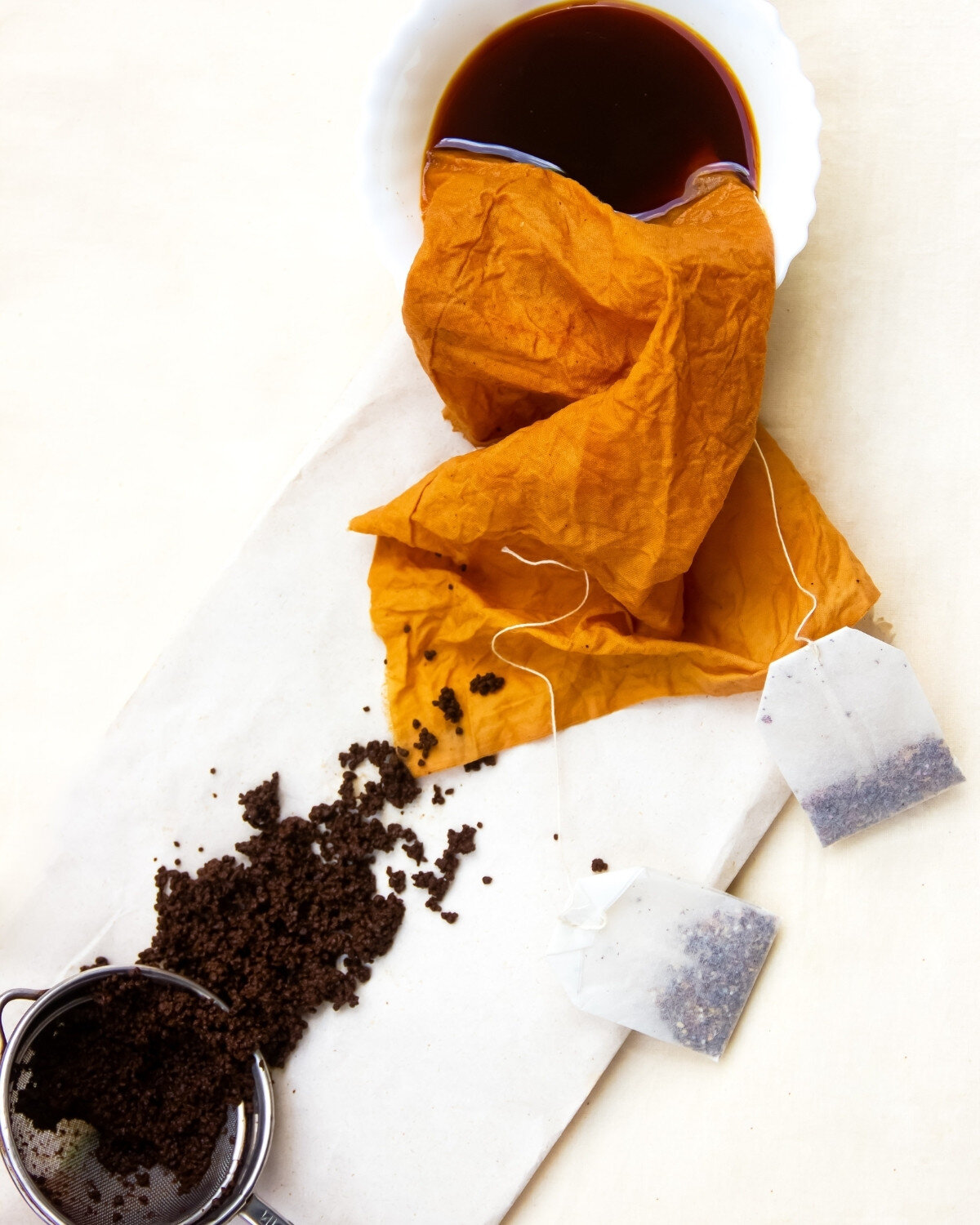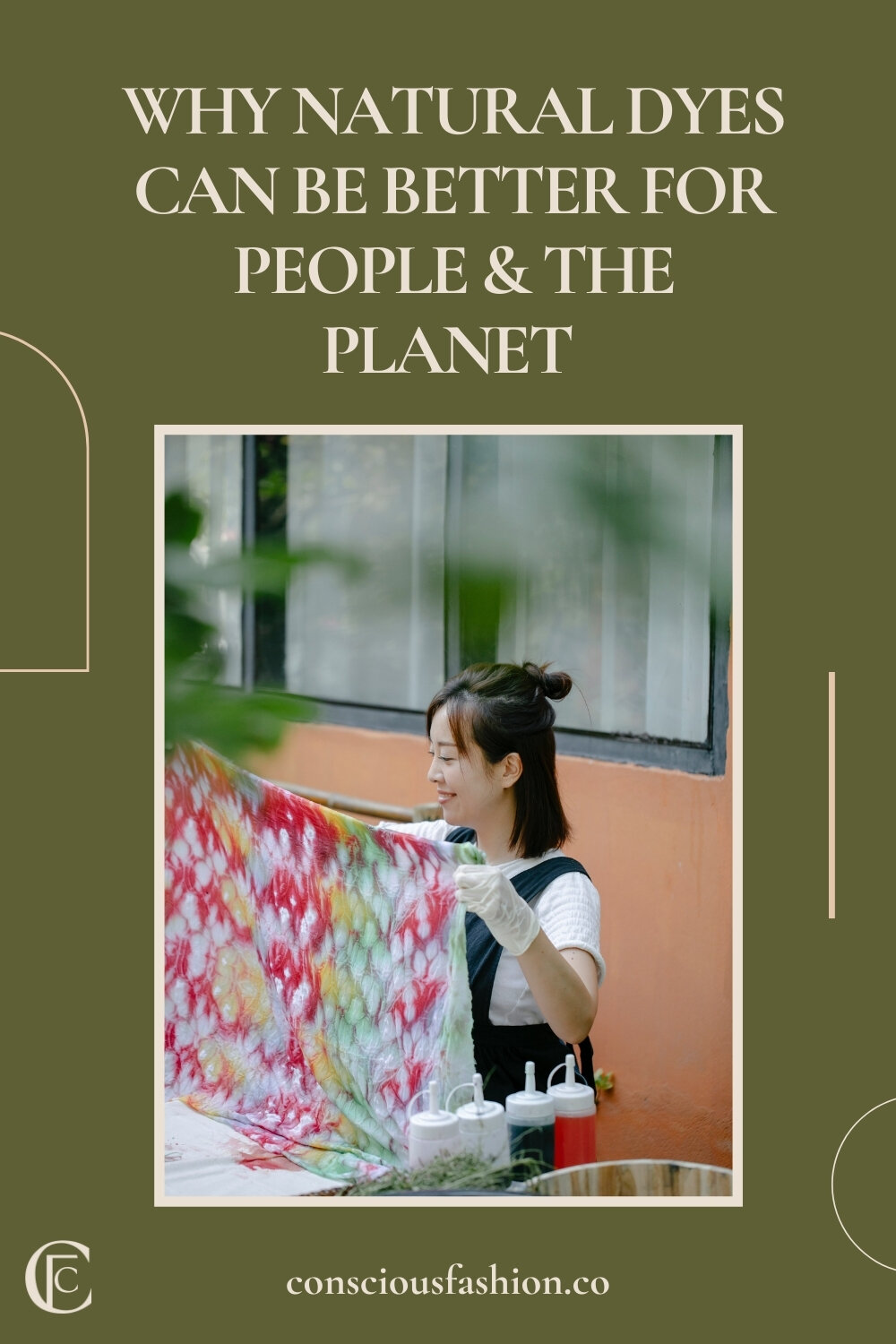Why Natural Dyes Can Be Better for People + the Planet (Plus 5 Accounts to follow for plant-dyed inspo!)
By Stella Hertantyo
Color is one of the first things that catches my eye when I walk into a clothing store. Color is deeply evocative and powerful. But, just like many things in the fashion world, often the story behind it isn’t nearly as pretty as the hues on the shelves.
Much of the water used in garment production is used during the dyeing phase. A recent article by McKinsey & Company revealed that approximately 25% of industrial water pollution comes from textile dyeing and treatment. Of the 1,900 chemicals used in clothing production, the European Union classifies 165 as hazardous to human health or the environment.
In this article, we will explore why synthetic dyes are so harmful, what the alternatives are, and a few natural dyes you can try at home.
So, why are synthetic dyes toxic for people and the planet?
Synthetic dyes are dyes that are made from fossil fuels, like coal or petroleum. Many of them can contain extremely toxic chemicals and heavy metals like chromium, mercury, and lead.
Synthetic dyes became widely used, because of their vast range of vibrant color choices and ability to retain those colors for many, many years. They are also much cheaper than natural dyes and can be used on several different fabric types.
But there is a true cost to these colors.
The ugly truth is that the cheapest way for factories to get rid of unusable, chemical-filled wastewater is to dump it into nearby rivers and lakes. This is because wastewater disposal is often unregulated or unpoliced, which means that big brands and factory owners don’t have to take responsibility for the effects of their actions. (What’s new?)
So, this water returns to nature as a cocktail of carcinogenic chemicals, residual dyes, salts, mordants, micro-fibers, and heavy metals that not only hurt the environment but pollute essential water sources used by surrounding communities.
If we look at the rivers near garment factories in manufacturing nations, we see this playing out in real-time. The heavy metals, chemicals, and oils in the water runoff make the water appear dark and give it a foul smell.
This opacity means that sunlight cannot penetrate the water, which is necessary for photosynthesis, resulting in a total loss of marine life and ecosystems. This cocktail of chemicals and inhibition of natural processes means that the water cannot self-purify, making it toxic for household use (such as drinking and bathing) and resulting in a loss of soil productivity in surrounding fields. The water in these rivers has become a public health crisis.
Garment workers who are in close contact with these dyes, daily, are at high risk. But they're not the only ones — these toxic dyes also impact the surrounding communities and anyone that relies on those polluted waterways.
The chemicals and metals increase the risks of various cancers, gastrointestinal problems, and skin diseases. Every season, the fashion industry picks a new ‘it’ color, and every season, new chemicals are introduced to these natural and social systems.
If you want to learn more about the impacts of the dye industry, the award-winning documentary, RiverBlue, takes the viewer on a shocking journey that details the fashion industry’s impact on waterways across the world, and the effects this has on human lives.
This may sound all too gloom and doom, but the good news is we do have other options!
There are, in fact, options that have been used in harmony with people and nature for centuries before synthetic dyes were first created. Let’s chat about natural dyes.
A brief history of natural dyes
Natural dyes are dyes derived from natural materials. Most are of plant origin and extracted from roots, wood, bark, berries, lichens, leaves, flowers, nuts, and seeds. Others come from insects, shellfish, and mineral compounds. These dyes were the only dyes used for textiles until synthetic dyes were created in the 1850s.
Three natural dyes that were common in ancient times were Indigo, Alizarin, and Logwood:
Indigo – Indigo has a distinctive deep blue color (think: the traditional denim color of jeans) derived from the leaves of dyer’s woad herb, isatis tinctoria, and the indigo plant, indigofera tinctoria.
Alizarin - Alizarin was a red dye extracted from the madder plant.
Logwood – Derived from the logwood plant, logwood dye is initially red but will transform to charcoal, purple, gray, and black once combined with chromium.
While the links between natural dyes and nature make it seem like the ultimate conscious fashion choice, the reality is slightly more complex.
Natural dyes and conscious fashion
What makes natural dyes a great choice for conscious fashion advocates is that the process is inherently slow and intentional.
The ingredients must be harvested, cultivated, or collected, and because the dyeing process is less predictable than synthetic dyes, it requires a creative eye and openness of mind.
It can also be a zero-waste alternative, especially when food waste is used for dyeing purposes.
These nuances in shade and the ever-changing hues are arguably part of their beauty and we all need to shift our mindset when it comes to how we perceive what fashion should be, and at what cost.
But the reality is that natural dyes do not hold their color in the same way as synthetic ones, which makes natural dyes less marketable and arguably prone to shorter wearability.
To achieve a brighter, longer-lasting color with natural dyes, mordants are used to bind the color to the fabric in the dyeing process.
Mordants are chemical compounds that form a bridge between the fiber and the dye. The textile is simmered in the mordant solution before being dyed.
When it comes to using ancient dyes in the modern world, it is important to note that there are two types of natural dyes – adjective (or additive) and substantive. The main difference between the two is adjective (or additive) dyes require a mordant to bond with fibers, while substantive dyes do not as they usually contain tannin which acts as a natural mordant.
Some mordants are made from metal salts like chromium, iron, and aluminum, and they also have the potential to be very toxic, which may have an impact on wastewater quality. This use of mordants is one of the reasons that there has been debate about the sustainability of natural dyes.
So, bear in mind that just because something is ‘natural’ does not mean it’s necessarily non-toxic or non-harmful to the environment. Conscious fashion brands need to take this use of mordants into account when considering their sustainability vision.
Substantive dyes, that don’t require mordants, contain tannin and mean that the range of colors is very limited. Mordants make colors last, so that they can be exposed to sunlight and washed multiple times, which extends the wearability of a garment, but some mordants come with their downsides.
This discussion around mordants is also why we need to be wary of big brands using natural dye on an industrial scale as another form of greenwashing. While natural dyes do not pollute waterways, chemical mordants do if not disposed of responsibly.
What this comes down to is the importance of transparency and how your brand communicates its processes, so that consumers can make informed decisions.
There is also a growing focus on low-impact, synthetic dyes which hold longer, have more colors than natural dyes, and increase wearability.
Other innovations are focussing on how to use dye chemicals that do not pose a concern to the environment. For example, chemical company Archroma has developed ‘Earthcolours’, a palette of dyes made from agricultural waste, and which are water- and energy-saving, iron- and formaldehyde-free, and can replace conventional oil-based dyes for cellulose-based fibers.
While there are complexities around sustainably upscaling natural dyes, they are still a great option for small, conscious fashion brands and for you to try at home if you are looking for a zero-waste textiles project, wanting to breathe some new life into an old item of clothing, and learn about ancient practices.
Four natural dyes that you can try at home
Before you begin, make sure you are using natural fiber textiles, such as wool, silk, cotton, or linen, because natural dye pigments only bond with natural fibers. Then, make sure you wash your textile at 194°F (90°C) before beginning the dyeing process to ensure that the dye holds. Without further ado, here are a few natural dyes you can try at home using ingredients that you may already have in your kitchen:
Onion skins
Color: Orange/brown
Tutorial: ‘How to dye fabric using onion skins’
Turmeric
Color: Bright yellow
Tutorial: ‘DIY: Dyeing with turmeric’
Avocado pits
Color: Soft pink
Red cabbage:
Color: Purple and blue
Tutorial: ‘Natural dyeing with red cabbage’
Billy Nou has a very informative series of dyeing tutorials (for each of the above ingredients and more) on YouTube if you would prefer to watch a tutorial.
Five accounts to follow for natural dye inspiration
If you are looking for some inspiration before trying out natural dyes for yourself, take a look at these accounts on Instagram that are using natural dyes in creative and conscious ways:
@maggie_pate
Maggie is a slow textile artist and natural dyer who also runs a natural dye studio (Nåde Studio). The color palette of her account is a feast for the eyes!
@charkhaghar
Charka Ghar is a textiles company focussing on natural dyes and eco prints. Their beautifully captured processes are sure to leave you wanting to try out dyeing for yourself.
@tinyikomakwakwa
Tinyiko is a textile artist and natural dyer who uses her fiber practice to look at pre-colonial techniques and crafts that are centuries old. Tinyiko reminds us of the ancient roots of these dyeing practices and will leave you curious to dive deeper and learn more.
@shoptessbee
Tessa runs a super fun online store offering curated vintage and planted dyed garments. Her items provide some great inspiration for how you could use natural dyes to upcycle items you already own in fun and creative ways.
@natural_dye_podcast
A podcast sharing the stories of people using color from nature and creating a community that shares knowledge and resources about natural dyeing practice. These stories and lived experiences with dyes illuminate the intricacies and joys of this practice.
Natural dyes are not going to solve all of the fashion industry’s problems. But, as with all of these articles, the goal is to inspire you to start thinking differently about your clothing and how what we wear is part of much larger global systems.
And, we hope this piece got you excited about dyeing alternatives and maybe even inspired to try a few natural dye experiments of your own!
ABOUT THE AUTHOR:
Stella Hertantyo is based in Cape Town, South Africa, and is currently completing her PGDip in Sustainable Development to accompany her undergraduate in Multimedia journalism. She is a slow-living enthusiast and a lover of low-impact fashion.
She is passionate about encouraging an approach to sustainability that is inclusive, accessible, and fun as we try to figure out how to create a more sustainable and just world, together.
When Stella is not in front of her laptop doing uni work, you'll probably find her reading, writing, illustrating, or baking/cooking. A dip in the ocean, or a walk in the mountains, are the two things that bring her the most peace.













